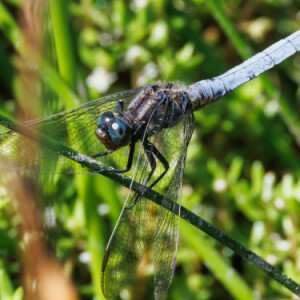Red-veined Darter
A second trip to the Knighton Reserve this morning got me the Red-veined Darter I failed to find yesterday, and also a third, unexpected "lifer", in the shape of the Keeled Skimmer I've added as an extra. This took my Odonata year list to twenty nine species, which was bumped to thirty later in the morning, when another photographer waved me over to a patch of gorse in which he'd spotted a fresh Golden-ringed Dragonfly.
If you compare this Red-veined Darter with yesterday's Scarlet, you'll see that they're distinctly different. The Red-veined is slightly smaller, and much more slender, lacking the leaf-shaped abdomen of the darker dragon. It's also a paler and cooler red than the Scarlet Darter - closer to crimson or rose than blood. The thorax is brownish, with a single pale diagonal stripe on the side, and the legs have a pale stripe like that of the Common Darter. The hindwing has a largish yellow patch at the base, and both wings have red veins towards their fore edges and bases. The most obvious distinguishing features though, are the two tone eyes - red above and blue below - which the Red-veined Darter shares with no other British darter, and the pale area running down the side of the frons. Females of this species, like many other female darters, are yellow, but they also have two-tone eyes -- brown above and blue below - and a pale stripe down the side of the frons; their wing veins are yellow, rather than red.
The Red-veined Darter has an interesting ecology, in that it's believed to be primarily an annual migrant species here, even though it's known to breed at a number of sites in southern England. It favours shallow lakes and pools that warm up quickly, and its larvae can develop there in as little as three or four months, allowing it to produce two generations a year. Odonatologists seem reluctant to commit to the idea that the larvae can overwinter in our climate, even though the first adults can appear early enough in the season to suggest that they must surely be home-grown. There's also a belief that at least some second-generation adults which emerge from UK lakes may then migrate south to the Continent to breed.
The Keeled Skimmer is smaller and slimmer than its cousin the Black-tailed Skimmer, and much rarer, being considerably fussier about its environment. The Black-tailed Skimmer can be found at almost any water body in England and Wales that has exposed margins on which it can bask, but the Keeled Skimmer is a heathland specialist, favouring acid bogs. The lake at Knighton is excellent territory for Black-tailed Skimmers and there were a large number present, but someone told me that they'd seen Keeled as well, and when I searched, I quickly found this male, which I identified by the pale stripes on the front of his thorax, and his yellow wing spots.
I don't know how this lake has come to support both skimmer species, but the Purbeck area is one of the Keeled Skimmer's strongholds, and it may simply be that high population density has caused organic spread of this little dragon into territory that on the face of it seems to be unsuitable. And despite the fact that it's heavily outnumbered by its bigger and more aggressive cousin, it does seem to be succeeding here: as I was leaving the site I spotted a teneral female dragonfly leaving the lake and settling in some nearby vegetation, and she also turned out to be a Keeled Skimmer.
En route back to the Shire I stopped off for an extra dragon walk at Ham Wall, where the searing heat and apparent dearth of Coenagrion damselflies soon had me regretting my decision. Luckily, that regret was assuaged by contact with several Emperors, Lesser Emperors, Norfolk Hawkers and Four-spotted Chasers, and eventually I managed to fulfil my self-appointed quest, by finding a single male Variable Damselfly among all the Common Blues, Blue-tails and Small Red-eyes. I'm not absolutely saying that this was the one and only Variable Damselfly in the entire reserve, but... I actually think it might have been. Anyway, one is all you need, and he took my 2025 list to thirty one species, which is the highest count I've yet managed in a season.


Comments
Sign in or get an account to comment.


